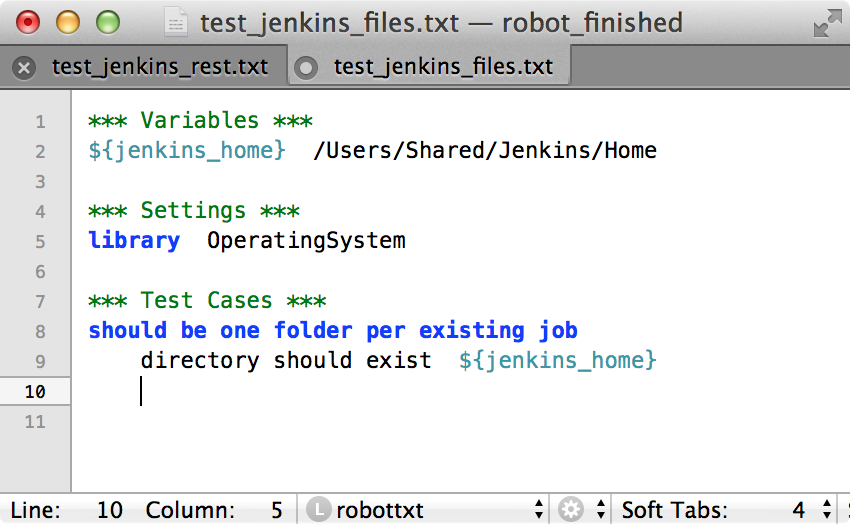Robot Framework Tutorial 2016 Part 1: Part 2: Part 3: Part 4: Part 5: Part 6: Integration with Jenkins Part 7: Part 8: Part 9: In the previous article of this series we have seen. This time we take a look at the. Having worked with Jenkins in countless (well, almost) projects it is really nice writing this blog post. And we will see that integration between the Robot Framework and Jenkins is really really easy. Installation Installing the Jenkins CI-Server is pretty straightforward.
Under Mac OS it comes with an installer that is working flawless. It is a typical setup that the Robot Framework is installed on the same server as the Jenkins. After the installation only a few steps are required before we can start to create the first job. First of all we need to unlock the installation by providing the key from the file shown in the initial Jenkins screen. (As a default Jenkins is running on.) This is not primary a blog post on Jenkins itself, but installation of the suggested plugins makes a lot of sense as otherwise some really basic features are missing (like checking out files from GIT). The following screenshot gives an idea on what is installed here. We are ready to create our first job executing Robot Framework tests.
Selenium has become a core framework for other open-source test automation tools such as Katalon Studio, Watir, Protractor, and Robot Framework. Selenium supports multiple system environments (Windows, Mac, Linux) and browsers (Chrome, Firefox, IE, and Headless browsers).

Robot Framework Selenium For Mac Mac
Robot Framework – Freestyle Execution The easiest way to execute the Robot Framework on Jenkins is to create a new Freestyle job. If you are just trying out this example with a brand-new Jenkins installation it might be that you are asked to login. At least I did not had/knew any valid user and for evaluation purposes a user is simply not required. Just search for the Jenkins configuration.xml by issuing this command: sudo grep --include=*.xml -rnw '/' -e 'true' And in the found configuration.xml change true -> false in the line: true Then restart Jenkins by killing it from the command line (in my case it just restarted and no login was required anymore to create jobs): ps -e| grep jenkins sudo kill -9 PID Now the nice thing is that we are having. Thus we can use those for our demo job as in a real life example the tests would be under version control as well. Then we can add a build script that is simply executing a shell. And then it only requires a few commands (of course we would add this to a fixed shell script in a real project) to execute our tests.
Unfortunately Jenkins does not serve certain HTML files and thus is is not possible to directly access the report.html and log.html that are stored now in the reports-directory below the workspace. One might, but that is of course a consideration of security vs.
Another possibility is to publish the reports to some directory that is directly served by a different web server. So let’s try out the later solution by starting an Apache web server in addition and storing the reports from the execution to its httpd-directory. This requires only a small change to our Jenkins job. (Happy who has:-).) To avoid problems with permissions I put my httpd-directory to: /Users/Shared/httpd/reports. Again in a real life example we would of course put more emphasis on security concepts here.
Macscan 3 mac malware removal for mac. MacScan will find and clean malware threatening your Mac, including: • Trojan Horses • Keystroke Loggers • Spyware • Adware • Worms • Scareware Still not convinced you need protection?. Protects your Mac by scanning for and removing malware – providing much-needed security and privacy in the face of online threats. Malware authors are targeting OS X with increasing frequency and even with more Mac malware activity now than ever before, many users are still unprotected against these threats. Is essential these days.
Now we can add a nice link to the generated Robot Framework report to the description of the Jenkins job. For this to work still one tiny detail needs to be done as HTML is not allowed per default in the description of a Jenkins job. This needs to be enabled in the settings. The result when opening the job page then looks like this. Of course we could still make things more fancy, but hopefully this shows all the basics needed to get started with Robot Framework jobs on Jenkins. But wait, there is some more cool stuff coming around the corner in the next chapter:-). Robot Framework PlugIn for Jenkins As usual the best things are kept until the end:-).
Selenium Framework Tutorial
Using the Robot Framework PlugIn for Jenkins is really a nice enhancement to present the Robot Framework results. Installing the PlugIn is a no-brainer from the buildin Jenkins PlugIn page: Once the PlugIn is installed we only have to do minor modifications to our existing job to take it into use. First of all we are again storing the Robot Framework results to some folder in our Jenkins workspace. To not break our integration with the Apache installation we are copying the files still to the corresponding httpd-directory in addition.

 0 kommentar(er)
0 kommentar(er)
